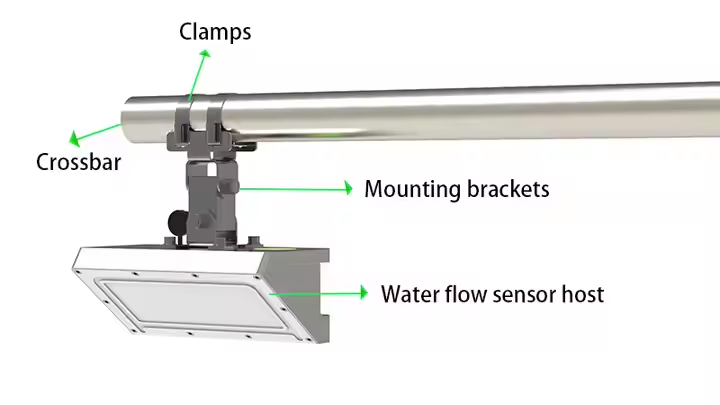Santiago, Chili - 11 Februari 2025- Ing negara sing manajemen banyu dadi saya kritis amarga owah-owahan iklim lan kekeringan sing dawa,sensor tingkat aliran banyu radarnggawe ombak ing pendekatan Chile kanggo manajemen sumber daya banyu sing lestari. Teknologi inovatif iki ngidini panguwasa lan pemangku kepentingan pertanian kanggo ngawasi lan ngontrol aliran banyu kanthi luwih tepat tinimbang sadurunge, njanjeni keuntungan sing signifikan kanggo ekonomi lan lingkungan.
Peningkatan Pengelolaan Sumber Daya Air
Kelangkaan banyu wis dadi masalah sing penting ing Chili, utamane ing wilayah kayata Lembah Tengah, ing ngendi produksi tetanèn dadi tulang punggung ekonomi nasional. Swara dasawarsa kepungkur, sawetara kahanan garing lan kurang banyu wis mengaruhi asil panen lan kasedhiyan banyu. Kanggo nanggepi, pamrentah wis ngupaya solusi teknologi kanggo ningkatake manajemen sumber daya banyu.
Radar sensor laju aliran banyunggunakake teknologi canggih kanggo nyedhiyakake pangukuran aliran banyu ing kali, saluran irigasi, lan waduk kanthi terus-terusan. Ora kaya cara pangukuran aliran tradhisional sing asring mbutuhake kontak fisik karo banyu, sensor radar iki beroperasi non-invasif, ngirim lan nampa sinyal gelombang mikro kanggo ngitung tingkat aliran kanthi akurat. Teknologi iki ora mung nyuda biaya pangopènan nanging uga nyuda dampak lingkungan sing ana gandhengane karo teknik pangukuran invasif.
Wuku kanggo Tetanèn
Pertanian minangka salah sawijining sektor sing entuk manfaat transformatifsensor tingkat aliran banyu radar. Kanthi data sing akurat babagan tingkat aliran banyu, para petani bisa ngoptimalake praktik irigasi, nyuda limbah banyu lan ningkatake produktivitas panen. Miturut Kementerian Pertanian, adopsi sensor kasebut nyebabake nyuda panggunaan banyu 30% ing peternakan sing melu nalika njaga utawa malah nambah panenan.
“Implementasinesensor aliran radarwis ngganti cara kita ngatur sumber daya banyu kita, "ujare Francisco Morales, petani ing Central Valley. "Saiki kita bisa nyetel sistem irigasi adhedhasar data nyata-wektu, mesthekake yen kita nggunakake mung apa kita perlu. Iki ora mung ngirit banyu nanging uga mbantu ngirit biaya.
Dampak Lingkungan
Manfaat lingkungan saka implementasinesensor aliran banyu radarngluwihi tetanèn. Pangukuran aliran sing akurat mbisakake manajemen ekosistem kali sing luwih apik, sing penting kanggo njaga keanekaragaman hayati. Kajaba iku, manajemen sumber daya banyu sing luwih apik bisa mbantu nyuda efek saka kahanan garing lan kurang banyu, nyebabake ekosistem lan komunitas sing luwih tahan banting.
Pamrentah Chile uga wis ngakoni peran kasebutsensor tingkat aliran banyu radaring ngatasi owah-owahan iklim. Kanthi ningkatake pemantauan banyu, negara kasebut duwe tujuan kanggo nglindhungi sumber daya banyu sing penting, supaya wilayah kutha lan deso bisa berkembang. Macem-macem inisiatif ditindakake, kalebu nggabungake sensor radar menyang sistem pemantauan banyu nasional kanggo nambah visibilitas lan responsif sakabèhé.
Tantangan lan Prospek Masa Depan
Senadyan kaluwihan pinunjul, rollout sakasensor tingkat aliran banyu radaring Chili wis ngadhepi tantangan. Biaya wiwitan sing dhuwur lan kabutuhan latihan teknis ing deso wis nyuda adopsi. Nanging, macem-macem LSM lan program pemerintah ngupayakake subsidi biaya lan nyedhiyakake program pelatihan kanggo nggampangake panggunaan sing nyebar ing sektor pertanian.
Nalika Chile katon ing mangsa ngarep, kemitraan antarane pamrentah, sektor swasta, lan panyedhiya teknologi bakal dadi penting kanggo ngembangaketeknologi sensor radarnegoro. Kanthi nandur modal ing solusi manajemen banyu sing canggih, Chili bisa mbukak dalan kanggo praktik pertanian sing luwih lestari, nglindhungi sumber daya banyu, lan pungkasane nambah daya tahan komunitas marang pengaruh perubahan iklim.
Kesimpulan
Pambuka sakasensor tingkat aliran banyu radarngowahi manajemen banyu ing Chili, menehi suar pangarep-arep kanggo ngadhepi tantangan kelangkaan banyu. Kanthi investasi lan inovasi sing terus-terusan ing wilayah iki, Chile wis siap kanggo mimpin praktik banyu sing lestari, ngimbangi kabutuhan tetanèn, ekosistem, lan komunitas ing donya sing saya keterbatasan sumber daya. Nalika teknologi kasebut dadi luwih terpadu ing praktik saben dina, masa depan manajemen banyu ing Chili katon luwih cerah lan luwih lestari tinimbang sadurunge.
Kanggo luwihwaterradarinformasi sensor,
hubungi Honde Technology Co., LTD.
Email: info@hondetech.com
Situs web perusahaan: www.hondetechco.com
Wektu kirim: Feb-11-2025


